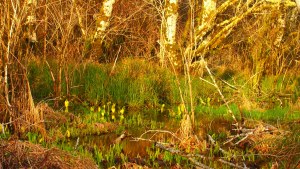 Whenever I hear something about wetlands, it seems like it’s something about their declining health or complete disappearance. I’ve never really thought about them forming or how that would even happen. Well, one way is to have a neighbor’s culvert back up for a year and let the creek feeding the river do the rest. Our lower field, between the cabin and the river, is about 30′ below the rest of the property – and it belongs to the river. During really heavy, prolonged rains or quick melting of snowpack in the coast range, the field floods and joins the river for a while. Otherwise, it is mostly dry except for the lowest spots where the water table is teasing the surface and is a little soggy.
Whenever I hear something about wetlands, it seems like it’s something about their declining health or complete disappearance. I’ve never really thought about them forming or how that would even happen. Well, one way is to have a neighbor’s culvert back up for a year and let the creek feeding the river do the rest. Our lower field, between the cabin and the river, is about 30′ below the rest of the property – and it belongs to the river. During really heavy, prolonged rains or quick melting of snowpack in the coast range, the field floods and joins the river for a while. Otherwise, it is mostly dry except for the lowest spots where the water table is teasing the surface and is a little soggy. 
 Until a couple of years ago, that is… that blocked culvert had slowly backed up the tiny creek into the field and formed a fairly large wetland area. It created a fertile area for young fish, tadpoles, birds and beavers. Even though our neighbor finally cleared the blockage, something has changed the behavior of the water because it no longer drains as it did before and has left a swampy gauntlet to cross to get to the river.
Until a couple of years ago, that is… that blocked culvert had slowly backed up the tiny creek into the field and formed a fairly large wetland area. It created a fertile area for young fish, tadpoles, birds and beavers. Even though our neighbor finally cleared the blockage, something has changed the behavior of the water because it no longer drains as it did before and has left a swampy gauntlet to cross to get to the river. This is going to make it tough to get the tractor down there to mow once the grass starts growing. The upside is we have hundreds of ducks that overnight here now. There is also a pair of herons that like to stop by every once in a while and flocks of geese who layover on their way to wherever they’re headed.
This is going to make it tough to get the tractor down there to mow once the grass starts growing. The upside is we have hundreds of ducks that overnight here now. There is also a pair of herons that like to stop by every once in a while and flocks of geese who layover on their way to wherever they’re headed.  I may have to build a small bridge over our new wetland so that we can get the most use of the lower field but overall it think that it is a good development and I look forward to seeing it progress. -MJ
I may have to build a small bridge over our new wetland so that we can get the most use of the lower field but overall it think that it is a good development and I look forward to seeing it progress. -MJ
